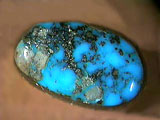![]()
Name:
Turquoise

Chem:
CuAl6(PO4)4(OH)8
* 5H2O
Hydrous copper aluminum phosphate
Crystal:
Triclinic (crystals are rare, usually compact or massive blocks)
Color:
sky blue, bluish-green, pale green
Refrac. Index:
1.61 - 1.65
Birefraction:
0.04
Hardness:
5 - 6
Spec. Grav.:
2.60 - 2.80
Fracture:
conchoidal
Cleavage:
none
Environment:
a secondary mineral in the alteration zone in hydrothermal replacement deposits
Association:
quartz, pyrite, chalcopyrite, apatite
Locals:
| Iran | Az., Nv., N.M., USA | Egypt | Afghanistan |
Misc:
The name comes from the French "turquoise", which means "Turkey" as in the original great localities in Persia (today Iran). Soluble in hot HCl
Gem info:
Turquoise has been used and coveted since before 4000 BC. It can be pure in color or may contain secondary minerals or even matrix. If the matrix forms a pattern of interlocking polygons it is sometimes called "spider-web" turquoise.
The associate minerals often make the original local easy to pin-point. The very best material still comes from Iran today. It has a one of the highest values of opaque gemstones and is second only to a few varieties of jade and the highest quality lapis.
It was used in much of the early American Indian jewelry and was often mixed with red-coral, pink-coral, or malachite. Today it is often found in intarsia with lapis, sugilite, and even opal.
A chalky variety is sometimes pressure treated with a plastic-polymer to make "stabilized" turquoise. It is worth far less than the non-stabilized material.